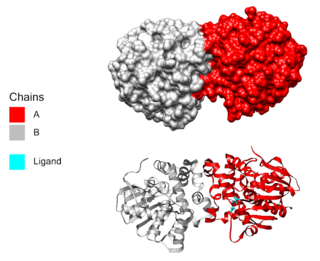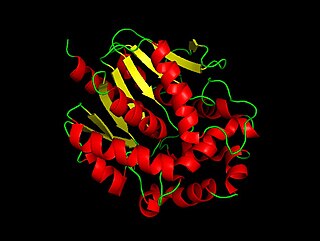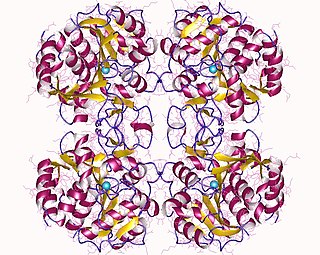A halohydrin dehalogenase is an enzyme involved in the bacterial degradation of vicinal halohydrins. In several species of bacteria, it catalyses the dehalogenation of halohydrins to produce the corresponding epoxides. Different isoforms of the enzyme fall into one of three groups, A, B or C. Halogenases of the same class are genetically similar, but differ greatly from halogenases from a different group. Currently the most well-studied isoform is HheC which is purified from the bacterial species Agrobacterium radiobacter. The ability to dehalogenate organic compounds as well as form enantiomeric selective epoxides have generated interest in the potential of this enzyme in the biochemical field.
In enzymology, a succinylglutamate-semialdehyde dehydrogenase (EC 1.2.1.71) is an enzyme that catalyzes the chemical reaction
In enzymology, a 5beta-cholestane-3alpha,7alpha-diol 12alpha-hydroxylase (EC 1.14.13.96) is an enzyme that catalyzes the chemical reaction
In enzymology, a 4-chlorobenzoate dehalogenase (EC 3.8.1.6) is an enzyme that catalyzes the chemical reaction
In enzymology, a 4-chlorobenzoyl-CoA dehalogenase (EC 3.8.1.7) is an enzyme that catalyzes the chemical reaction

In enzymology, a haloacetate dehalogenase (EC 3.8.1.3) is an enzyme that catalyzes the chemical reaction

In enzymology, a haloalkane dehalogenase (EC 3.8.1.5) is an enzyme that catalyzes the chemical reaction
In enzymology, a (S)-2-haloacid dehalogenase (EC 3.8.1.2) is an enzyme that catalyzes the chemical reaction
In enzymology, a polar-amino-acid-transporting ATPase (EC 3.6.3.21) is an enzyme that catalyzes the chemical reaction
In enzymology, an UDP-sugar diphosphatase (EC 3.6.1.45) is an enzyme that catalyzes the chemical reaction
The enzyme carboxylesterase (or carboxylic-ester hydrolase, EC 3.1.1.1; systematic name carboxylic-ester hydrolase) catalyzes reactions of the following form:

In enzymology, a purine nucleosidase (EC 3.2.2.1) is an enzyme that catalyzes the chemical reaction

Haloacid dehalogenase-like hydrolase domain-containing protein 1A is an enzyme that in humans is encoded by the HDHD1A gene. It encodes a pseudouridine-5'-phosphatase but can also accommodate other phopshorylated metabolites with a lower affinity.

Haloacid dehalogenase-like hydrolase domain-containing protein 2 is an enzyme that in humans is encoded by the HDHD2 gene.
EC 3.8.1 is the Nomenclature Committee of the International Union of Biochemistry and Molecular Biology's (NC-IUBMB) classification for C-Halide compounds.
Phosphoethanolamine/phosphocholine phosphatase (EC 3.1.3.75, PHOSPHO1, 3X11A; systematic name phosphoethanolamine phosphohydrolase) is an enzyme highly expressed in mineralizing cells. This enzyme is implicated in bone and cartilage formation and catalyses the following chemical reactions:
2-haloacid dehalogenase (configuration-inverting) (EC 3.8.1.10, 2-haloalkanoic acid dehalogenase, 2-haloalkanoid acid halidohydrolase, DL-2-haloacid dehalogenase, DL-2-haloacid dehalogenase (inversion of configuration), DL-2-haloacid halidohydrolase (inversion of configuration), DL-DEXi, (R,S)-2-haloacid dehalogenase (configuration-inverting)) is an enzyme with systematic name (S)-2-haloacid dehalogenase (configuration-inverting). This enzyme catalyses the following chemical reaction
2-haloacid dehalogenase (configuration-retaining) (EC 3.8.1.11, 2-haloalkanoic acid dehalogenase, 2-haloalkanoid acid halidohydrolase, DL-2-haloacid dehalogenase, DL-DEXr) is an enzyme with systematic name (S)-2-haloacid dehalogenase (configuration-retaining). This enzyme catalyses the following chemical reaction
Adsorbable organic halides (AOX) is a measure of the organic halogen load at a sampling site such as soil from a land fill, water, or sewage waste. The procedure measures chlorine, bromine, and iodine as equivalent halogens, but does not measure fluorine levels in the sample.
Reductive dehaholagenses (EC 1.97.1.8) are a group of enzymes utilized in organohalide respiring bacteria. These enzymes are mostly attached to the periplasmic side of the cytoplasmic membrane and play a central role in energy-conserving respiratory process for organohalide respiring bacteria by reducing organohalides. During such reductive dehalogenation reaction, organohalides are used as terminal electron acceptors. They catalyze the following general reactions:





